I’m a big fan of little links. Internal links are the underrated workhorse of SEO and UX. They’re easy to make, easy to manage …and easy to overlook. But not today.
This post is a guide to a powerhouse internal linking strategy. We’ll review three types of internal links that make a huge difference in results. Each of which you can easily add to your website. But first…
What’s an internal link?
An internal link is a link from one page to another page on the same domain. They’re simply text hyperlinks from one page to another page on your website. Of course, your website navigation is an example of internal linking, but here we’re talking about links on the page, in the content.
What’s an external link?
An external link is a link from one website to another. Links to your site from other sites are important for referral traffic and SEO, but they’re on other sites. You can’t control them.But internal links are easy. When done well, they help search engines and visitors.
Just want the list of ten internal linking best practices? Jump down to the tips at the bottom.
3 Benefits of an Internal Linking Structure
Internal linking is important for at least three reasons. They strengthen three parts of your funnel.
- They pass authority from one page to another (search optimization)
- They guide visitors to high-value, relevant content (usability / UX)
- They prompt visitors to act, as calls-to-action (conversion optimization)
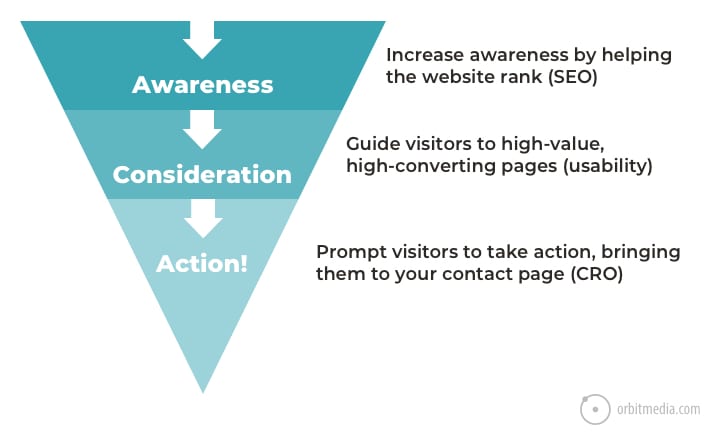
How do internal links affect SEO?
Authority flows through the Internet through links.
Links pass ranking potential from website to website, from page to page.
When one page links to another, it passes some of its credibility to that page, increasing the likelihood that the second page will rank. This credibility is sometimes called “link juice” which sounds gross. Most search optimizers simply call it “authority.”
Links from other websites to your website pass “Domain Authority” increasing the authority (and ranking potential) of all the pages on your website. Internal links don’t do that.
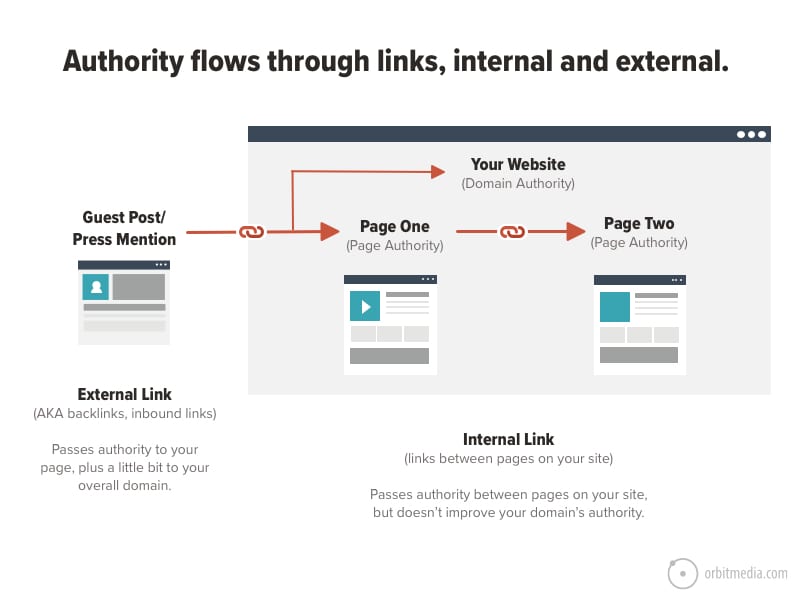
Internal links pass authority between pages on your website. They don’t increase your Domain Authority, but they do pass “page authority” from one page to another. Through internal links, pages can help each other rank in search engines.
Related: The value of an external link depends on several factors.
Internal Link #1: Links That Affect Search Engine Rankings (SEO)
Here’s how to get the most SEO value from internal links:
- Some of your pages have more authority than others. These are pages that already have been linked to from other sites. Your home page is the best example.
Links from these pages to other pages will pass more authority and SEO value. - Some of your pages will benefit from a bit more authority than other pages. These are pages that may be ranking, but not that high. Maybe they’re ranking high on page two. If that’s the case, a little more authority might go a long way.
Links to these pages might help your rankings more.
Linking from the first type of page to the second is easy, free and fast. And it may make a difference in ranking and traffic. Here’s a three step process to find both types of pages and your best internal linking opportunities.
1. Which of your pages has the most authority?
For this, you can use an SEO tool such as Moz, or a free tool such as Google Search Console.
In Moz, it’s the “Top Pages” report. It will show you all of your pages, ranked in order of Page Authority. Links from pages with higher authority will pass the most ranking potential. These are the pages you want to link from.

No subscription to SEO software? No worries. Just look in Google Search Console in the Links > External Links / Top Linked Pages report. This shows the pages that have the most external links and therefore the most authority. Sort by “Source Domains.” Your homepage will likely be at the top, but scan down to interior pages.
See any older, authoritative blog posts? These are the pages that can pass the most ranking potential.

Tip: Google Search Console also has a report showing which of your pages already has the most internal links pointing to it. Go to Links > Internal Links / Top Linked Pages, and take a look.
2. Which of your pages is almost ranking high?
Use Google Analytics to find the “low hanging fruit.” We’re going to do some SEO analysis and find the pages that are ranking right there in search results, but just past that page two tipping point.
2a. Go to the Acquisition > Search Engine Optimization > Queries report. If you aren’t getting a lot of traffic from search, just set a longer date range and you’ll get more data.

No data in this report? No problem. You just need to connect Google Analytics to Google Search Console. Or go straight to GSC and get it directly!
2b. Create an advanced filter so you can see just the phrases for which you rank higher than 10 (as in, the “average position” is greater than ten, which generally means you rank at the top of page two in Google). Here’s what that filter will look like:

2c. Sort by average position. Here’s your list of phrases for which you almost rank high…

2d. Go to Google and search for each phrase to confirm the ranking and find the corresponding page. Don’t be surprised if some of the phrases are hard to find. If you have trouble finding a phrase from the queries report in your search results, don’t dwell on it. Just move on to the next one.
The tool SEMrush makes it even easier to get this data, but you’ll need a paid subscription (worth it!) Go to Domain Analytics > Organic Research > Organic Search Positions. There’s a drop down there that will quickly filter the rankings to show you just the page two phrases.
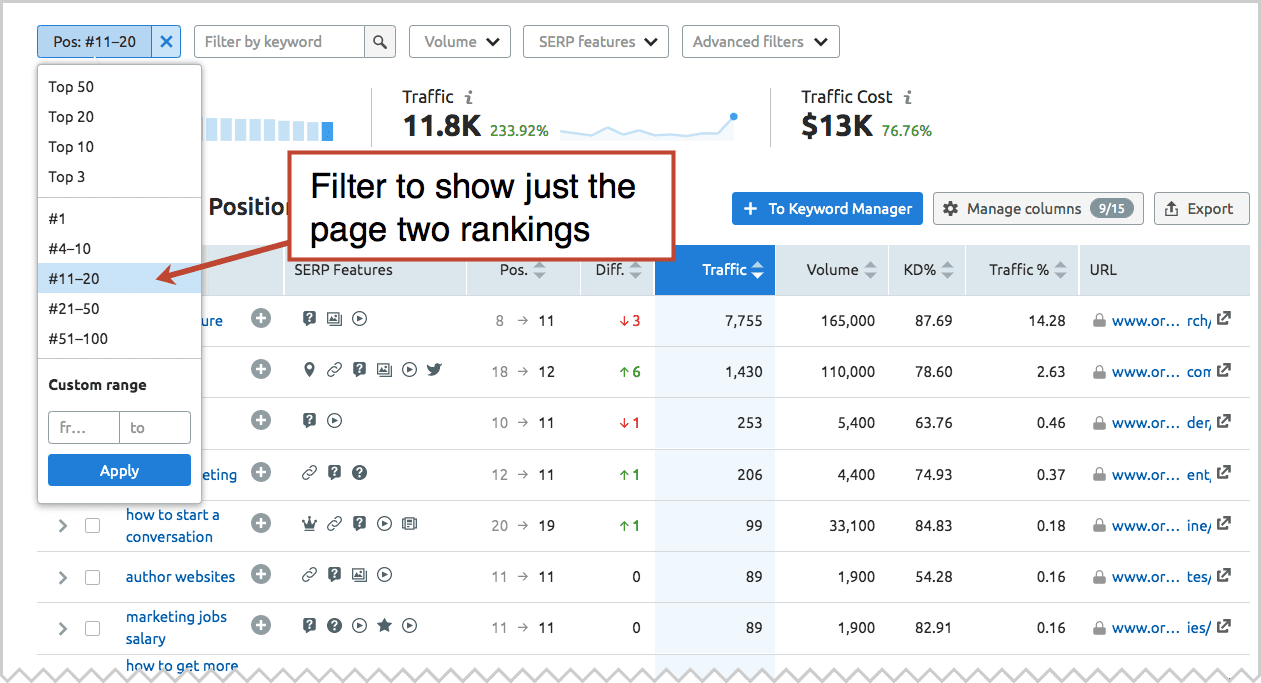
Also, notice the far right column. This report shows you the page that ranks. Nice, right? The Google Search Console > Queries report doesn’t do that.
Hopefully, you find a few great pages ranking at the top of page two, ready for more authority and more visibility. Now you know just what to link to.
3. Link from the first page to the second.
From the high-authority page, just create a link somewhere within the body text of the page, to the almost-high-ranking page. A few tips:
- If it makes sense, use the keyphrase in the anchor text of the link. For example, a link with anchor text that says “cable installation tips” would help indicate that the page is about cable installation. Keyword-focused anchor text is probably better than “read more” or “click here.”
Does Google care about keywords in anchor text? Probably, yes. It’s been suggested by John Mueller on Twitter…

…and in the Topic-Sensitive PageRank patent…

- Don’t force it. The link should be created with the reader in mind, not just rankings. Anything that you do purely for the sake of SEO, without any consideration for people, is spam.
Let’s ask search marketing expert, Kevin Indig, about the efficacy of internal linking structure for SEO. We just had to reach out to Kevin after reading his guide on internal linking. It is extremely thorough and highly recommended.
Internal links work very similar to external backlinks in terms of relevance and authority. If you link from a page on your site that gets strong backlinks to a weak one, you should notice a significant impact. The same happens with anchor text: it provides search engines a bit of context about the link target. Now, if you optimize that idea at scale, say by adjusting the pattern of an internal link module or any other logic related to internal links, you have a powerful tool to improve Google’s understanding of your content and increase your chance to rank higher. To take that idea a level higher, you also manage expectations of your audience better when using descriptive anchor text.
Kevin Indig, VP of SEO and Content, G2
This one simple link may be enough to push the rank up a bit of the page. If it doesn’t work, don’t give up. It may be time to improve the page in other ways.
Internal Link #2: Links That Guide Visitors to High Converting Pages
Some pages attract a lot of visitors. Usually, this is because they already rank high or they get shared a lot. They are your traffic champions.
Other pages inspire a lot of visitors to take action. In content marketing, this is usually because they do a good job of converting visitors into subscribers. They are your conversion champions.
Linking your traffic champions to your conversion champions can have a dramatic impact on your marketing. One little link can help connect your best cheese to your best mouse traps.
Here’s how to find your best cheese, your best mousetraps and connect them with an internal link.
1. Which of your pages attracts the most traffic?
This is easy to check in Analytics. Just go to the Behavior > Site Content > Landing Pages report. Choose a nice long date range of three to six months. The report is sorted in order of the pages that had been viewed the most. Here’s your list of traffic champions.

Caution: As you scan down the list, think about pages that had traffic spikes due to PR hits or email campaigns. Keep in mind that those events won’t repeat themselves.
2. Which of your pages inspire the most action?
The Landing Pages report does show a conversion rate on the right, as long as you’ve set up goals in Google Analytics. Switch to your newsletter signup goal from the drop down menu and sort. You’ll get a quick idea for which posts grow your email list the fastest.
Note: If you see mostly outliers and ultra-low numbers, add a filter. Here you can see I’m looking at just the landing pages that drive 5+ conversions.
Here are your conversion champs:

If you’d like to do more accurate, detailed analysis, you can connect Google Analytics to Google Sheets. Just follow these detailed instructions.
This is what your chart will look like. Bring this one to your next content marketing meeting and watch the social media team spring into action.
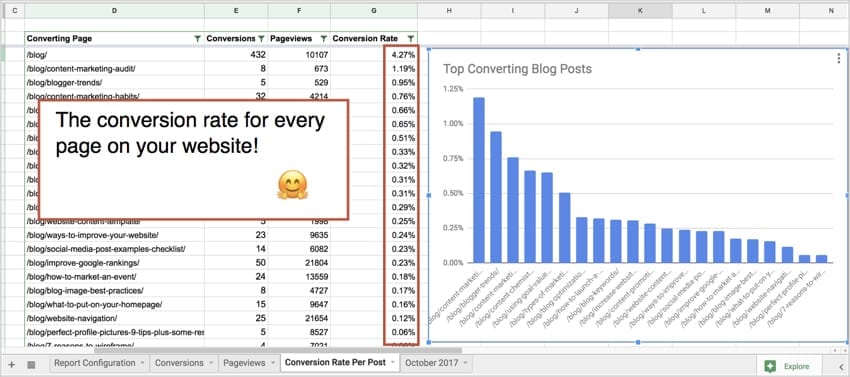
3. Link from the traffic champions to the conversion champions
Finally, add the internal link. Somewhere in the body text of the high-traffic pages, link to the high-converting pages. The more people click this link, the faster your email list will grow. So make it a compelling, specific call to action.
You just connect your best cheese to your best mousetrap.
Internal Link #3: Links That Prompt Visitors to Act (Calls-to-Action)
Your goal as a digital marketer is to attract visitors, present them with powerful marketing claims, support these claims with evidence and then gently guide them to take action.
Calls to Action are internal links. They prompt visitors to act.
Look at the bottom of any of your marketing pages. What is the last line of text? Does it suggest the visitor take action? Does it offer help? Does it start a conversation? Or does the page just abruptly end?
Here are some examples of internal links that you can put at the bottom of your marketing pages, that serve as calls to action.

You can imagine this little internal link helps generate leads.
Pro Tip! Make sure that no page on your website is a dead end. Find and remove every dead end on your website. It will keep the visitors flowing.
10 Internal Linking Best Practices
Let’s put it all together into a set of best practices for internal linking. What do these links look like? How many do you add? And where do you add them?
1. Add internal links wherever it helps your readers
Think of your visitor. Would a link here improve their experience? If so, link. It should feel natural.
Even if you’re thinking about SEO, make every link with the visitor and the click in mind. Lose sight of this, and you me start doing some very strange things, like adding internal links inside CTA boxes.
Just look at this…

2. Link between pages in the body of the article
The context of each link is important. Most SEOs believe that links within the body copy are weighted more heavily than links within the navigation or the footer.
3. Link from new to old and from old to new
Got a new post that relates to an older, high-value post or page? Add a link. Got an older post that’s still getting traffic from search engines or social sharing? Add a link.
You’re not done publishing a new page until you’ve linked to it from an old page
Tip: Use the Google search operator to search your own site for related pages: “site:www.yoursite.com [keyword].” This is a way to quickly see all the mentions of the target phrase on all the pages of your site. Each of these pages are candidates for internal linking.
Example: I just published an article about bounce rates. I can use Google to find every mention of the phrase “bounce rates” on my site. Each of these instances of the phrase is an opportunity to link to my new article.
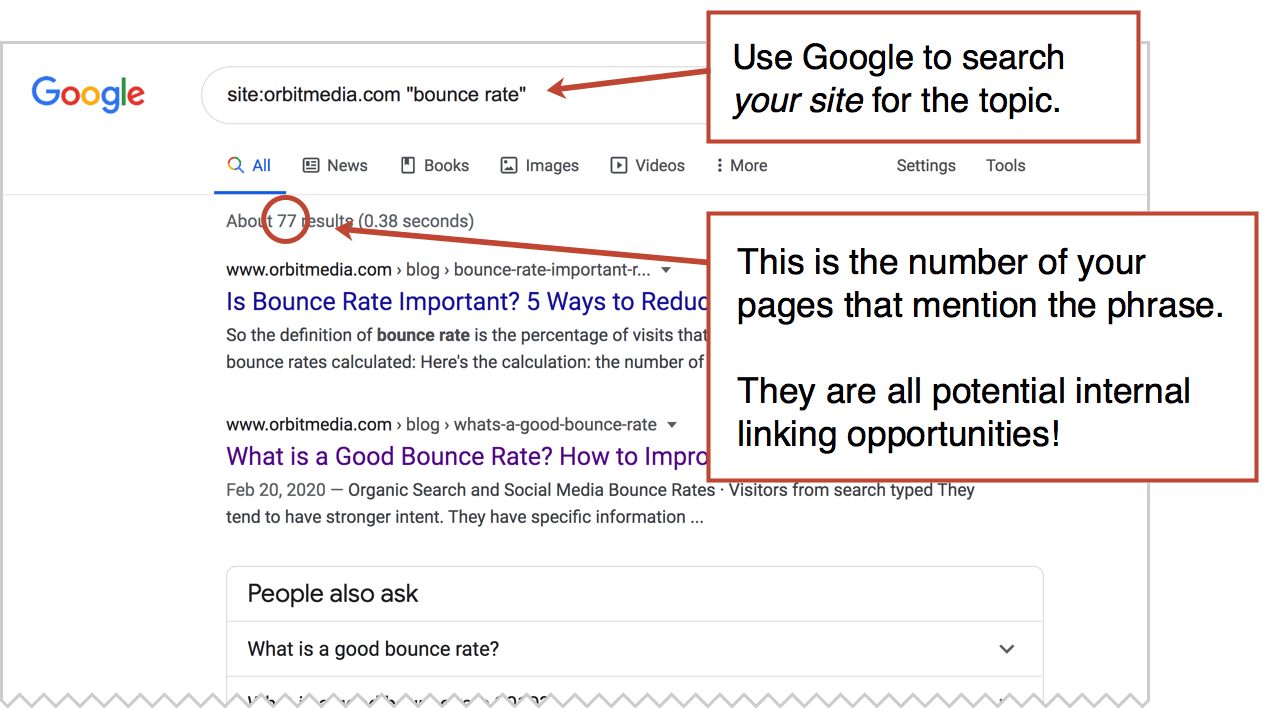
4. Link from pages with high authority to pages that almost rank high
This is how internal links help SEO. See instructions above.
5. Link from pages with high traffic to pages that have high conversion rates
This is how internal links can grow your list. See instructions above.
6. Use descriptive (and keyword-focused) anchor text in the text of the link
Use the target keyword of the page you’re linking to in the anchor text. When the link text includes the target keyphrase, it helps indicate the relevance of the page to Google.
You may need to get creative to find ways to use longer phrases as links.
Example: “Learning cable installation safety tips is always important.” Notice how the text within the link includes the target phrase of the page it’s linking to.
7. Can’t find ways to use keywords within the anchor text? Add “Related Links”
No need to get too fancy. Just add a “Related link” after a relevant paragraph, linking to your article using the headlines (which likely includes the target keyphrase) as the link text.
8. Make sure every sales page has a Call to Action
This is your most important internal link because it guides the visitor toward the conversion. So make sure there is a CTA on every sales page on your site.
And when you make that CTA, watch your verbs. “Click here” and “Contact Us” aren’t really calls to action.
9. Don’t overdo it
The total number of links on any page, including the navigation, should never be more than 75-100. Anything beyond that is just too much.
Fewer links means more authority will be passed through each of the links. Use our simple Web Page Analyzer (beta) to quickly count you the number of links and buttons on any page.
10. Find and fix broken internal links!
Bad links are bad for UX and SEO. You can find them using a broken link checker like Screaming Frog (not free) or just let Analytics show you (gratis!)
Go to Behavior > Site Content and select “Page Title” as your dimension. Then filter this report for “Page Not Found” (or whatever the title of your 404 page is).

This report is a list of bad URLs. Click on any of them, the click on the Navigation Summary above the reports. See the “Previous Page Path” list? Those are pages with broken internal links.
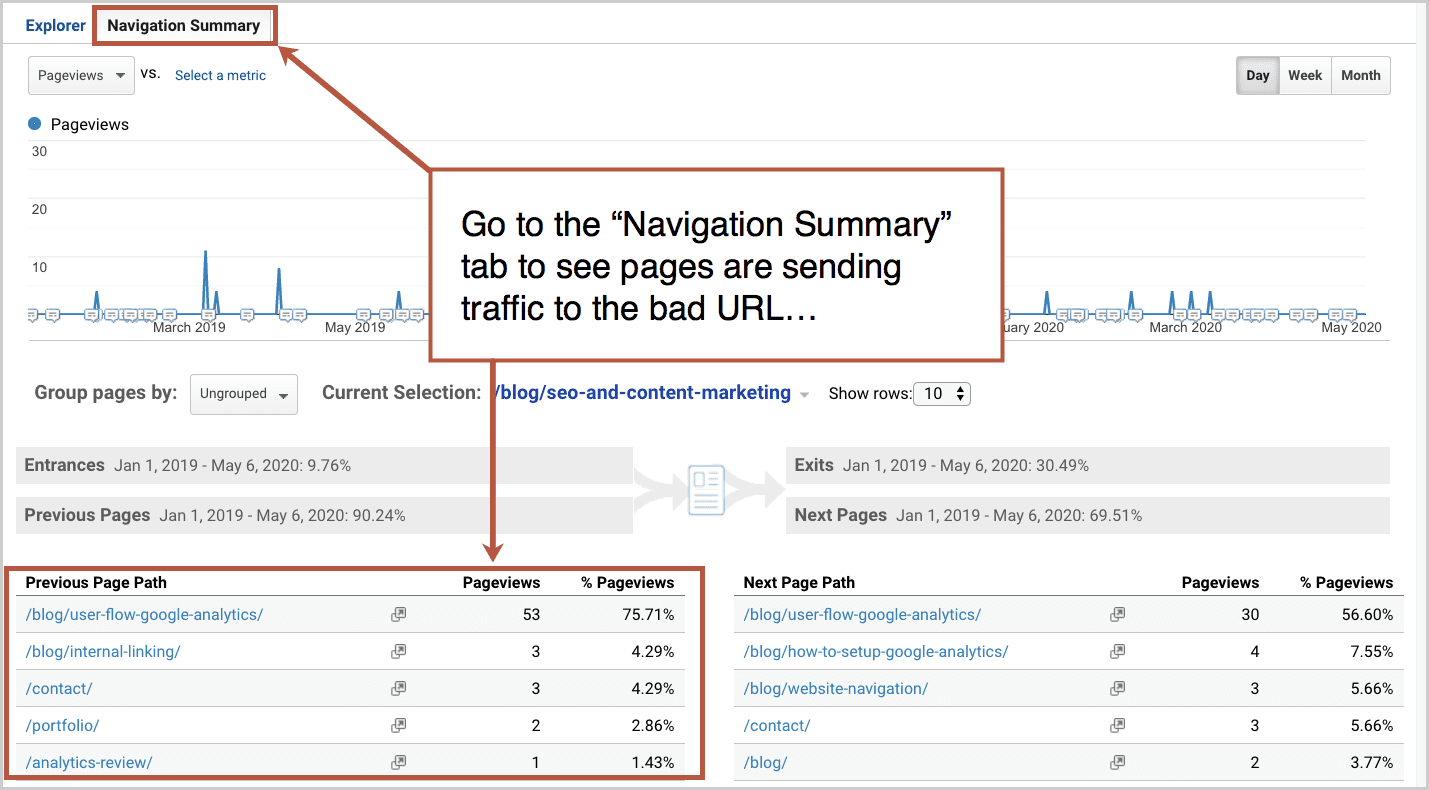
This is one of several fast ways that Analytics can help you find bugs on your website.
Little Connections That Make a Big Difference
You have total control over your website, so internal links are the easiest links to manage. Just log into WordPress, Drupal or whatever CMS you use and add them.
Take a look at your internal links, add some, polish them a bit and then move on. Don’t spend days thinking about these. Give your site a check-up a few times per year, then go back to the other activities that improve traffic and conversions!




